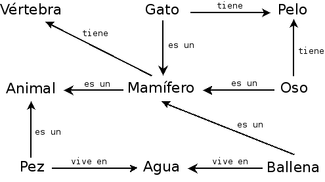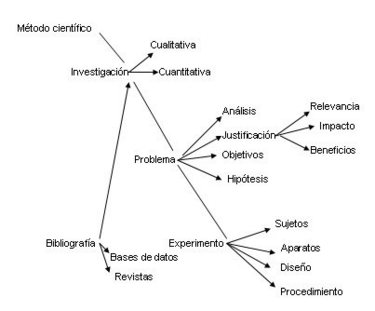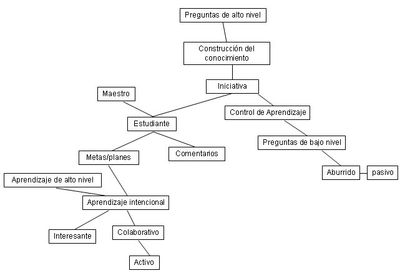Semantic network
A semantic network or network representation scheme is a form of linguistic knowledge representation in which concepts and their interrelationships are represented by a graph. In case there are no cycles, these networks can be visualized as trees. Semantic networks are used, among other things, to represent conceptual and mental maps. In a semantic graph or network, the semantic elements are represented by nodes. Two semantic elements between which the semantic relationship represented by the network is admitted, will be linked by a line, arrow or link or edge. Certain types of non-symmetric relationships require directed graphs that use arrows instead of lines.
Note that the concept of Semantic Web is different from Semantic Network. In English the Semantic Web is referred to as "Semantic Web", while a Semantic Network would be called "Semantic Network".
Definition
There are various types of semantic relationships such as hyponymy, hyperonymy, meronymy, etc. Given a set of concepts, semantic elements, or terms that are semantically related through some semantic relationship, a semantic network represents these relationships in the form of a graph. Explicitly, given a set of terms {t1, t2,..., t n} and some symmetric semantic relation between them, a graph G = (V,A) meeting the following conditions:
- The whole V is the set of vertices or nodes of the graph. This set will consist of n elements (such vertices as relational terms). To each of the vertices of the graph will represent one of the terms, therefore the vertices of the graph will be called: t1, t2,... tn.
- The whole A is the set of edges or lines of the graph. Given two vertices (terms) of the graph ti and tj There will be a line aij that unites the vertices ti and tj Yes and only if the terms of the pony ti and tj They're related.
If the relationship is not symmetric, then directed graphs are used to represent the relationship.
History
Those responsible for the first formalized representation schemes were Quillian (1968) and Shapiro & Woodmansee (1971). Semantic network schemes have a very solid psychological foundation, so numerous efforts have been made to carry out important implementations based on them.
One of the first network models was the Teachable Language Comprehender developed by Quillian (1969) used to describe semantic knowledge. Memory network models were originally developed to describe schematic relationships. Quillian (1962, 1967) proposed that concepts can be represented by nodes or locations within a network structure. The links between individual nodes represent the associations between the related concepts. For each node there are links to other nodes and these in turn are linked to others (Collins and Loftus, 1975). Within the network model, the meaning of a word is a function of the concepts to which it is connected. There is a complex system of interconnections between concepts that is seen as a representation of the richness and complexity of human semantic memory.
An important characteristic of semantic networks is their ability to relate concepts and to retrieve information, to extract semantic knowledge from textual information. The network model is widely used in the world of computing to retrieve information from gigantic databases quickly and efficiently.
Semantic networks have been widely used in Artificial Intelligence to represent knowledge and therefore there has been a great diversification of techniques. The basic elements that we find in all network schemes are:
- Data structures in nodes, which represent concepts, coupled with arches that represent the relationships between concepts.
- A set of inference procedures operating on data structures.
Basically, we can distinguish three categories of semantic networks:
- IS-A networks, in which the links between nodes are tagged.
- Conceptual graphics: in which there are two types of nodes: concepts and relationships
- Frame Networks: where the linking points are part of the node tag.
Semantic network models can be tested empirically by asking subjects questions about the relationship between two concepts, the closer the semantic distance within the hierarchical network, the shorter the reaction time to answer. The first models of semantic networks were hierarchical in nature with superordinate and subordinate concepts. The information is stored as attributes of each node, which are also shared by the subordinate nodes.
Another form of semantic network is the one developed by Pathfinder (Schvaneveldt, 1990) which is a scalar procedure used to summarize and graphically represent the relationship scores between pairs of concepts. Pathfinder is a multivariate descriptive statistical technique that represents in the form of a network the proximity of the pairs of concepts, the network obtained can be measured and compared quantitatively (Goldsmith and Davenport, 1990).
Contenido relacionado
Ututo
Quechua languages
Transport Layer Security


